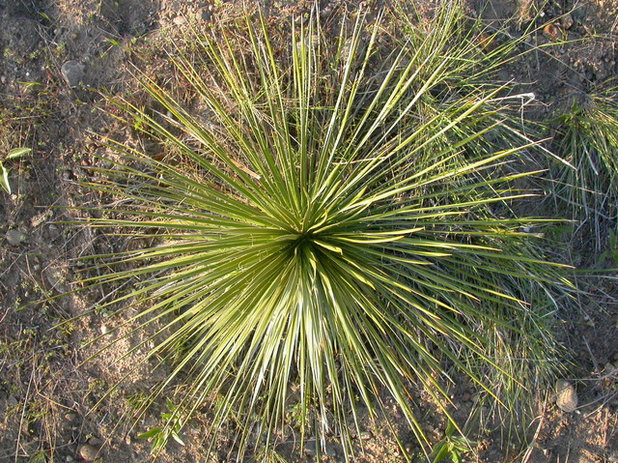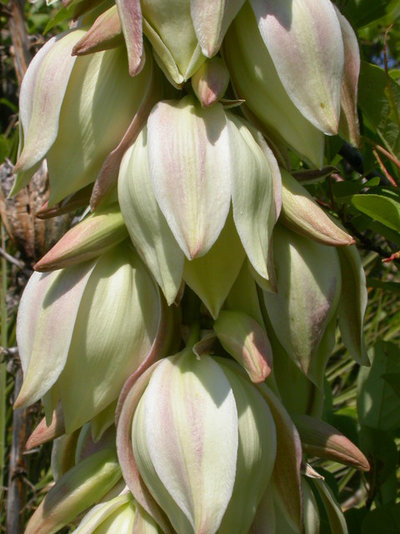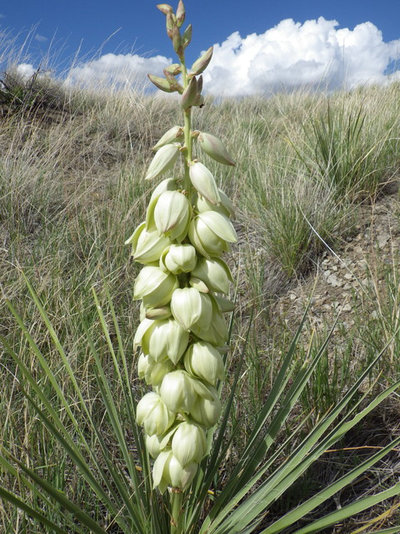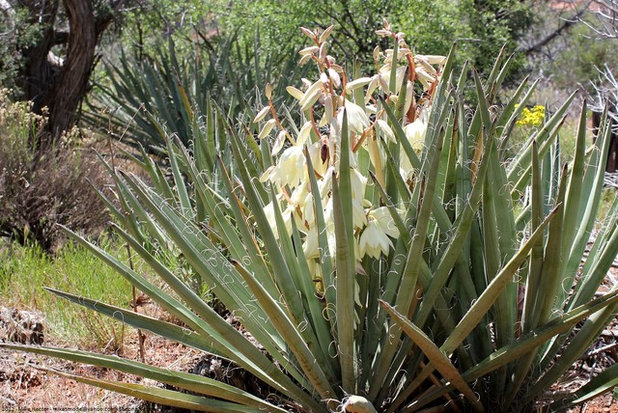Beloved for its spiky, punk-rocker silhouette and dramatic flower stalks, soapweed yucca (
Yucca glauca) is a long-lived shrub from the Great Plains and Rocky Mountain foothills that tolerates cold and drought.
Its bell-shaped, downward-hanging flowers are the sole food and nesting habitat for a species of night-flying moth; the nectar and pollen also attract hummingbirds and other pollinators. The ball of its spine-tipped leaves offers shelter to a wide variety of small wildlife.

Talus
Botanical name: Yucca glaucaCommon names: Soapweed yucca, plains yucca, narrowleaf yucca
Origin: Native to the Great Plains and foothills of the Rocky Mountains from Alberta, Canada, to northern New Mexico, and east as far as Arkansas
Where it will grow: Hardy to minus 40 degrees Fahrenheit, or minus 40 degrees Celsius (USDA zones 2 to 6; find your zone)
Water requirement: Drought-tolerant once established
Light requirement: Full sun to partial shade
Mature size: 3 feet tall and wide, with a flower stalk as tall as 6 feet
 Benefits and tolerances:
Benefits and tolerances: Late-spring and early-summer flowers offer food for moths, native bees and songbirds; heat- and drought-tolerant; deer-proof
Seasonal interest: Stiff leaves stay evergreen in winter and turn darker green in spring and summer; dramatic flower stalk and blooms in late spring and early summer; fall seedpods
When to plant: Late summer or fall
Photo by Matt Lavin
 Distinguishing traits.
Distinguishing traits. Soapweed yucca’s upright stem and tight ball-shaped cluster of long, narrow leaves are distinctive. The bloom stalks are called “Our Lord’s candles” in the Southwest for the large, bell-shaped flowers that hang downward; their waxy ivory petals are tinged green to pale purple. These woody perennials may live several decades or more in the garden, budding daughter plants from the main stem.
The flowers attract pollinators, including native bees, beetles, hummingbirds and a species of night-flying moth called the yucca moth (
Noctua pronuba)
. Female moths pollinate individual flowers to ensure they will produce seeds as food for the moth larvae and then lay a few eggs in each flower’s ovary. The moth larvae hatch and eat the seeds but mature into adult moths before all are consumed, thus ensuring new yucca plants for future generations of pronuba moths. The two species are interdependent: without the moth, the yucca plants produce far fewer viable seeds; without the yucca, pronuba larvae starve.
Photo by Matt Lavin

Aphids on the fleshy flower stalks attract feeding orioles and other songbirds. Stalks and woody seedpods provide nesting habitat for solitary bees, small rodents, songbirds and lizards. Deer avoid the stiff, sharply pointed leaves; in fact, yucca can provide a living deer fence to protect plants deer readily browse.
Soapweed yucca roots have been used for soap and fiber for millenniums; Native Americans traditionally wove the tough fiber into rope, fishing lines, mats and even sandals.
How to use it. Plant as a focal point in desert-style gardens at the back of a border, where its tall flower stalk will stand out, or where its stiff ball of leaves will provide evergreen color and a formal touch in winter. Set plants back from paths, driveways or play areas for children or pets to avoid contact with the spike-tipped leaves.
Photo by Matt Lavin

Mike Hector
Planting notes. Plant potted specimens in late summer or early fall while the soil is still warm enough to promote root growth. Soapweed yucca prefers well-drained soil; for clay soil, banana yucca (
Y. baccata), shown here, is a better choice.
Soapweed yucca can also be started from seed. The relatively large, black seeds germinate readily in moist soil after being chilled for two to three months, and the seedlings grow quickly enough in nursery conditions that they can often be planted outdoors the first summer.
Daughter plants can be separated from the main stem and transplanted. (Wear gloves when handling them.)
Other species: Banana yucca (
Y. baccata) is similar, with wider leaves and a shorter profile. Banana yucca is native to the Southern Plains and desert Southwest but is reliably hardy as far north as Fort Collins, Colorado.





